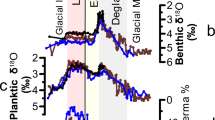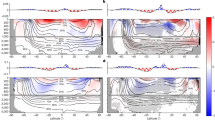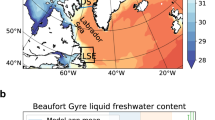Abstract
Freshening in the Canada basin of the Arctic Ocean began in the 1990s1,2 and continued3 to at least the end of 2008. By then, the Arctic Ocean might have gained four times as much fresh water as comprised the Great Salinity Anomaly4,5of the 1970s, raising the spectre of slowing global ocean circulation6. Freshening has been attributed to increased sea ice melting1 and contributions from runoff7, but a leading explanation has been a strengthening of the Beaufort High—a characteristic peak in sea level atmospheric pressure2,8—which tends to accelerate an anticyclonic (clockwise) wind pattern causing convergence of fresh surface water. Limited observations have made this explanation difficult to verify, and observations of increasing freshwater content under a weakened Beaufort High suggest that other factors2 must be affecting freshwater content. Here we use observations to show that during a time of record reductions in ice extent from 2005 to 2008, the dominant freshwater content changes were an increase in the Canada basin balanced by a decrease in the Eurasian basin. Observations are drawn from satellite data (sea surface height and ocean-bottom pressure) and in situ data. The freshwater changes were due to a cyclonic (anticlockwise) shift in the ocean pathway of Eurasian runoff forced by strengthening of the west-to-east Northern Hemisphere atmospheric circulation characterized by an increased Arctic Oscillation9 index. Our results confirm that runoff is an important influence on the Arctic Ocean and establish that the spatial and temporal manifestations of the runoff pathways are modulated by the Arctic Oscillation, rather than the strength of the wind-driven Beaufort Gyre circulation.
This is a preview of subscription content, access via your institution
Access options
Subscribe to this journal
Receive 51 print issues and online access
$199.00 per year
only $3.90 per issue
Buy this article
- Purchase on SpringerLink
- Instant access to full article PDF
Prices may be subject to local taxes which are calculated during checkout




Similar content being viewed by others
References
McPhee, M. G., Stanton, T. P., Morison, J. H. & Martinson, D. G. Freshening of the upper ocean in the Arctic: is perennial sea ice disappearing? Geophys. Res. Lett. 25, 1729–1732 (1998)
Proshutinsky, A. et al. Beaufort Gyre freshwater reservoir: state and variability from observations. J. Geophys. Res. 114, C00A10, http://dx.doi.org/10.1029/2008JC005104 (2009)
Rabe, B. et al. An assessment of Arctic Ocean freshwater content changes from the 1990s to the 2006–2008 period. Deep Sea Res. I 58, 173–185 (2011)
McPhee, M. G., Proshutinsky, A., Morison, J., Steele, M. & Alkire, M. Rapid change in freshwater content of the Arctic Ocean. Geophys. Res. Lett. 36, L10602, http://dx.doi.org/10.1029/2009GL037525 (2009)
Dickson, R. R., Meincke, J., Malmberg, S. A. & Lee, A. J. The ‘Great Salinity Anomaly’ in the northern North Atlantic 1968–1982. Prog. Oceanogr. 20, 103–151 (1988)
Proshutinsky, A. Y. & Johnson, M. A. Two circulation regimes of the wind-driven Arctic Ocean. J. Geophys. Res. 102, 12493–12514 (1997)
Macdonald, R. W., Carmack, E. C., McLaughlin, F. A., Falkner, K. K. & Swift, J. H. Connections among ice, runoff and atmospheric forcing in the Beaufort Gyre. Geophys. Res. Lett. 26, 2223–2226 (1999)
Proshutinsky, A., Bourke, R. H. & McLaughlin, F. A. The role of the Beaufort Gyre in Arctic climate variability: seasonal to decadal climate scales. Geophys. Res. Lett. 29, 2100, http://dx.doi.org/10.1029/2002GL015847 (2002)
Thompson, D. W. J. & Wallace, J. M. The Arctic Oscillation signature in the wintertime geopotential height and temperature fields. Geophys. Res. Lett. 25, 1297–1300 (1998)
Morison, J., Steele, M. & Andersen, R. Hydrography of the upper Arctic Ocean measured from the nuclear submarine USS Pargo. Deep Sea Res. I 45, 15–38 (1998)
Carmack, E. C. et al. Changes in temperature and tracer distributions within the Arctic Ocean: results from the 1994 Arctic Ocean Section. Deep Sea Res. II 44, 1487–1502 (1997)
Environmental Working Group (EWG). Joint U.S.-Russian Atlas of the Arctic Ocean, Oceanography Atlas for the Winter Period (National Ocean Data Center (NODC), 1997)
Morison, J., Aagaard, K. & Steele, M. Recent environmental changes in the Arctic. Arctic 53, 359–371 (2000)
Lique, C. et al. Evolution of the Arctic Ocean Salinity, 2007–08: contrast between the Canadian and the Eurasian Basins. J. Clim. 24, 1705–1717 (2011)
Kwok, R. & Morison, J. Dynamic topography of the ice-covered Arctic Ocean from ICESat. Geophys. Res. Lett. 38 L02501 http://dx.doi.org/10.1029/2010GL046063 (2011)
Alkire, M. B. et al. Sensor-based profiles of the NO parameter in the central Arctic and southern Canada Basin: new insights regarding the cold halocline. Deep Sea Res. I 57, 1432–1443 (2010)
Yamamoto-Kawai, M., McLaughlin, F. A., Carmack, E. C., Nishino, S. & Shimada, K. Freshwater budget of the Canada Basin, Arctic Ocean, from salinity, δ18O, and nutrients. J. Geophys. Res. 113 C01007 http://dx.doi.org/10.1029/2006JC003858 (2008)
Chambers, D. P. Observing seasonal steric sea level variations with GRACE and satellite altimetry. J. Geophys. Res. 111 C03010 http://dx.doi.org/10.1029/2005JC002914 (2006)
Willis, J. K., Chambers, D. P. & Nerem, R. S. Assessing the globally averaged sea level budget on seasonal to interannual timescales. J. Geophys. Res. 113 C06015 http://dx.doi.org/10.1029/2007JC004517 (2008)
Vinogradova, N., Ponte, R. M. & Stammer, D. Relation between sea level and bottom pressure and the vertical dependence of oceanic variability. Geophys. Res. Lett. 113, L03608, http://dx.doi.org/10.1029/2006GL028588 (2007)
Bingham, R. J. & Hughes, C. W. The relationship between sea-level and bottom pressure variability in an eddy permitting ocean model. Geophys. Res. Lett. 35 L03602 http://dx.doi.org/10.1029/2007GL032662 (2008)
Morison, J., Wahr, J., Kwok, R. & Peralta-Ferriz, C. Recent trends in Arctic Ocean mass distribution revealed by GRACE. Geophys. Res. Lett. 34, L07602, http://dx.doi.org/10.1029/2006GL029016 (2007)
Steele, M. & Ermold, W. Steric sea level change in the Northern Seas. J. Clim. 20, 403–417 (2007)
Kwok, R. et al. Thinning and volume loss of the Arctic Ocean sea ice cover: 2003–2008. J. Geophys. Res. 114 C07005 http://dx.doi.org/10.1029/2009JC005312 (2009)
Serreze, M. C. et al. The large-scale freshwater cycle of the Arctic. J. Geophys. Res. 111, C11010, http://dx.doi.org/10.1029/2005JC003424 (2006)
Ekwurzel, B., Schlosser, P., Mortlock, R. A., Fairbanks, R. G. & Swift, J. H. River runoff, sea ice meltwater, and Pacific water distribution and mean residence times in the Arctic Ocean. J. Geophys. Res. 106, 9075–9092 (2001)
Steele, M. & Boyd, T. Retreat of the cold halocline layer in the Arctic Ocean. J. Geophys. Res. 103, 10419–10435 (1998)
Shindell, D. T., Miller, R. L., Schmidt, G. A. & Pandolfo, L. Simulation of recent northern winter climate trends by greenhouse-gas forcing. Nature 399, 452–455 (1999)
Koldunov, N. V., Stammer, D. & Marotzke, J. Present-day Arctic sea ice variability in the coupled ECHAM5/MPI-OM model. J. Clim. 23, 2520–2543 (2010)
Walsh, J. E., Chapman, W. L., Romanovsky, V., Christensen, J. H. & Stendel, M. Global Climate Model performance over Alaska and Greenland. J. Clim. 21, 6156–6174 (2008)
Chambers, D. P. Evaluation of new GRACE time-variable gravity data over the ocean. Geophys. Res. Lett. 33, L17603 (2006)
Acknowledgements
This work was supported chiefly by NSF grants OPP 0352754, ARC-0634226, ARC-0856330 and NASA grant NNX08AH62G. R.K. was supported at the Jet Propulsion Laboratory, California Institute of Technology, under contract with NASA. GRACE ocean data were processed by D. P. Chambers, supported by the NASA MEASURES Program. We thank the NASA ICESat and GRACE programmes, K. Falkner, R. Collier, M. McPhee, W. Ermold, L. de Steur, A. Proshutinsky and the Beaufort Gyre Exploration Project, J. Toole and R. Krishfield and the Ice Tethered Profiler project at WHOI, and W. Smethie of the Switchyard project for the observations that made this work possible.
Author information
Authors and Affiliations
Contributions
The main idea was developed by J.M. and R.K. J.M. wrote most of the text and with R.A. and C.P.-F. drew most of the figures. R.K. developed the DOT records. The SLP and OBP anomaly plots were originally developed by C.P.-F. The 2008 hydrography observations were made by J.M., M.A., R.A. and M.S. The AO spatial pattern data, figures and insight were provided by I.R. The hydrographic data processing was done by R.A. and the chemistry analysis was done by M.A. Switchyard data and freshwater insight was provided by M.S. All authors discussed the results and commented on the manuscript.
Corresponding author
Ethics declarations
Competing interests
The authors declare no competing financial interests.
Supplementary information
Supplementary Information
This file contains Supplementary Text and Data, Supplementary References and Supplementary Figures 1-13 with legends. (PDF 13357 kb)
Rights and permissions
About this article
Cite this article
Morison, J., Kwok, R., Peralta-Ferriz, C. et al. Changing Arctic Ocean freshwater pathways. Nature 481, 66–70 (2012). https://doi.org/10.1038/nature10705
Received:
Accepted:
Published:
Issue Date:
DOI: https://doi.org/10.1038/nature10705
This article is cited by
-
Intense zonal freshwater transport in the Eurasian Arctic during ice-covered season revealed by in situ measurements
Scientific Reports (2023)
-
Arctic Sea Level Variability from Oceanic Reanalysis and Observations
Advances in Atmospheric Sciences (2023)
-
Observing the Central Arctic Atmosphere and Surface with University of Colorado uncrewed aircraft systems
Scientific Data (2022)
-
Trans-polar drift-pathways of riverine European microplastic
Scientific Reports (2022)
-
Arctic Ocean stratification set by sea level and freshwater inputs since the last ice age
Nature Geoscience (2021)



